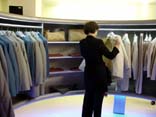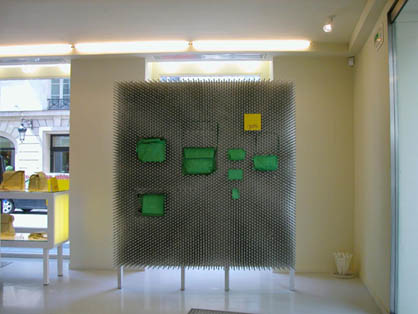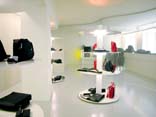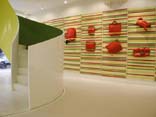|
|
|||||
| home > architetture | |||||
| NL
ARCHITECTS. Mandarina Duck |
|||||
| A
NEW SHOP. Mandarina Duck will extend its impressive reputation in the
field of designer bags with a collection of clothes and accessories,
the so-called small items. The reinvention of it's own identity (a perpetual
process in the fashion industry) asks for new shop design to present
the new product lines. Since shopping became the number one distraction
of the contemporary urbanite all important labels and brands are in
a 'battle' to create the most convincing environment for this new form
of entertainment. The new ideas are launched and tested in the main
platforms of the corporate identities, the flagship stores or ambassador
shops. From these focal points of exchange the new identity spreads
bit by bit over the local stores. |
[10mar2004] | ||||

|
 This notion was the starting point for 'a store with no architecture'; a shop that consists of furniture and products only. These will be orchestrated in any chosen environment, in any hull. The relatively 'light' elements will determine the display and atmosphere. If they turn out to be successful they can be used in other MD shop too. By using a catalogue of specifically designed Mandarina Duck furniture and inserting it in a specific spatial condition every new shop can be identified as MD but still appear very different from all others. Space can be considered the biggest luxury of all. In many stores this is apparent in the virtual absence of sellable items. The objective is to stress the exclusivity of the brand. The central idea of the New Shop is similar but different. The aim is to create a series of freestanding objects that are 'countable': the Cocoons. They direct a sense of spaciousness but at the same time contain numerous products in their interiors. The shop looks empty but is full. |
||||

|
 The Cocoons express their content in an indirect, derivative way. In a sexy fashion they conceal the objects of desire. The Pinwall shows the items as bulges from a wall, the vacuum wall presents them free floating and compressed, the Inverse Clothes Rack is a steel wrap around clothes on hangers, only accessible from its inside, some products are supported by light. The Incubator makes it possible to feel and hold the secured small items that are stored behind glass. Some of the dressing rooms are designed as circles in a cornfield. |
 
|
|||
 
|
 The first test case is Rue Saint Honoré in Paris. This shop will consists of two stories, the second bigger than the first. The classic problem of seducing clientele to enter a second level is countered with the Rotating Spiral Stair. The slow movement of this large helix is inviting, it is 'beaming you up' to the other floor. The advantage of this invention, besides its theme park-like attraction is logistic gain: every time you arrive on the second floor this will be in a different position. The Rotating Spiral Stair becomes a signboard in the interior, a logo for the shop: the enhanced symbol of itself. Elements Description: 1. Pallet Tunnel: It's an object made out of sculputural elements that are normally used for transportation of goods in a compact way: pallets. We made them out of a transluscent plastic in order to illuminate the object as a whole and let the items that are on display hint at their presence. The objective is to enhance a state of desire. The pallets wrap around creating a slightly higher floor in the object thus allowing a slightly different perpective through the shop. Once you're in the tunnel a more intimate relation with the products is established. 2. Incubator: The small items display. Normally these objects are behind glass and affection is only established visually. The incubator allows a more sensory experience; you can touch the items, hold them, feel them. 3. Inverse clothes rack: The sybol for the shop concept as a whole. Normally clothes racks expose their content explicitly; in the face. The shape of the inversed clothes rack is derived from it's content (clothes on hangers) thus indicating in a more indirect but hopefully more attractive way what it is about. Evoking a kind of curiousity, a longing for the products. The cocoon creates an identifyable ('countable') but strange object in the room in order to resolve the paradox to be exclusive and to have many products on display at the same time. 4. Counter = long in order to serve many customers and to put variable products or information on display. Color: Mandarina Duck Yellow. 5. Vacuumwall: Easy-to-change display for clothes. Two sheets of tranparant plastic hold the fashion item; they seem to be suspended in the air. 6. Curtain room: 3 Circular multi-platvorm displays for bags. 10 Kilometers of a small steel-beats-chain-curtain create a 'permeable wall', a 'room' that can be accessed or left at any point. The elegant curves appear as a result of the offset of the display dishes, such that you can freely browse around them. 7. Socle: mini version of pallet tunnel for display of bags. 8. Fluo-cupboards: shelfs made out of fluorescent light fixtures; products 'supported' by light only. No distinction between shelf and fixture. 9. Mirror boxes: a version of small items display. 10. Pinwall: aluminum steel pipes can be pushed in or out the surface such that products (mainly bags) can be displayed. On the shopwindow side of the pinwall the impression will be visible; the mergandize is shown in an indirect way: a 3D xray. NL Architects |
||||
|
Per
candidare progetti laboratorio
|
|||||